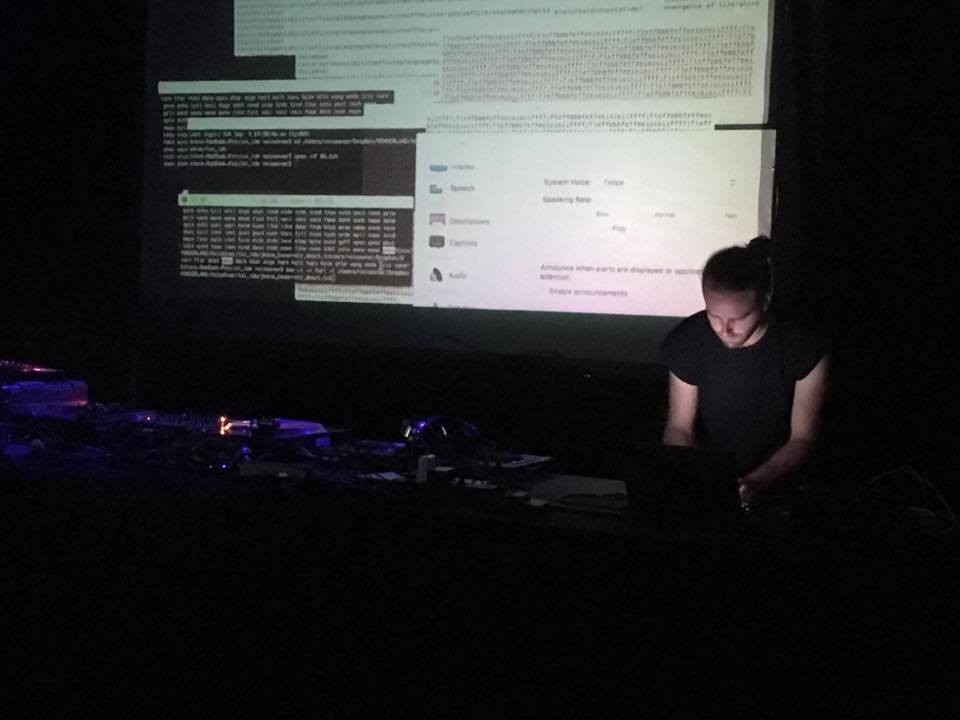VoiceOver is a sound and video performance making use of built-in text-to-speech (TTS) softwares in a live-coding and “program bending” fashion. The performance seeks out melodies, rhythms, and drones through the probing of voice synthesis utilities: by finding out letters, words, ponctuation, and parameter combinations that will transform the TTS utilities into experimental sound and visual instruments. While the software and technics I use are standard and accessible to any computer owner, their bending, reconfiguration, and repurposing offer a critical insight into TTS technologies: their parameters and imperfections are potential handles for artistic experimentation and user appropriation. VoiceOver takes the form of a live performance in which I write and manipulate my computer in realtime in front of an audience that can visualise my actions at the same time as they hear the synthesis emerging out of them. Spectators are encountering uncanny sounds and visuals, both human like and aesthetically digital, guiding them into a sonic journey for them to experience and, hopefully, get inspired.
Description
It all start from a word, first written, then spoken. Then a new one, repeated, broken down into letters, layered with yet another one. Each of those words are spoken out by the computer, copy-pasted, deconstructed, interpreted, and synthesised to eventually let drones, rhythms, and melodies emerge. VoiceOver takes the form of a sound and video performance: I play onstage alongside a projection of my computer screen. Spectators can witness how I generate sounds with the simplest programs such as text editors. This setting, similar to live-coding ones, intends to generate a humorous and intriguing tension by showing in the open the bending I apply to programs we are all used to.
Program bending
VoiceOver aims at creating sonic experiences and experimental music out of text-to-speech (TTS) utilities that can be found on any computer. Such voice over programs are originally intended to help visually impaired users to navigate their computers by voicing out loud the different items and words present on the screen. In the meantime those utilities can be “program bent” to generate experimental sound textures by tinkering with their parameters and the text typed in. In VoiceOver the act of performing consists in finding out the combinations of words, letters, and symbols that will push the program’s algorithms to their limits, to glitch, and to generate sound textures. It is an act close to circuit-bending practices in that it seeks to extend the aesthetic of digital sound art by exploring, appropriating, bending, and misusing the computer’s built-in softwares.
Uncanny voices
VoiceOver engages with the limits of the computer’s abilities to synthesise human voices. Instead of seeing those limits as defaults I use them as a material, as keys to transform black boxed processes into sound generators. What emerges out of those manipulations are melodies, drones, and rhythms that exploit the uncanniness of synthesised human voices. Letter and word combinations, speed and pitch parameters, national and gender presets, all participate to the emergence of sounds at the frontier between familiar human voices, and digital artefacts and glitches. Further than an artistic experience with uncanniness, this way of engaging with software technologies by imposing on them unexpected inputs and parameters critically mirror how humans are shaped by their technologies. Even before electronics, the printing press, and musical notation imposed constraints on composers and led to the emergence of new musical styles, human speech and cognition themselves got shaped by the development of writing. In particular the technical apparition of separations between written words, from the unseparated scriptio continua to the current use of spaces, has been deeply studied for its impact on text understanding, silent reading, and diction abilities. Reflectively, exploring how our technologies can be developed, extended, and repurposed by imposing on them constraints, rules, and practices they are not designed for can open the door to new aesthetics, theoretical concepts, and technological innovations.
Presentation:
ISI Lab 2017
Technique:
Program bending, TTS synthesis

